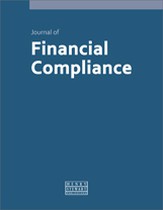Financial industry compliance with Big Data and analytics
Abstract
The use of Big Data, machine learning and artificial intelligence (AI) is rapidly reshaping the financial regulatory landscape and changing ways in which financial institutions manage risks and ensure regulatory compliance. On one side, regulators have begun to use advanced analytical tools designed to identify fraud and misconduct, predict market participants’ behaviour and detect aberrational patterns in the markets and registrant disclosures. On the other side, financial institutions are increasingly relying on RegTech to help mitigate risks and ensure compliance with relevant securities and commodities rules and regulations. As artificial intelligence programmes become more sophisticated and less predictable, new questions arise regarding the applicability of the current legal framework and liability theories to new technologies. This paper describes how financial firms and regulatory agencies are integrating artificial intelligence systems into their compliance and surveillance programmes, respectively. It then examines several legal theories that may hold firms or individuals liable for violations committed by advanced automated systems.
The full article is available to subscribers to the journal.
Author's Biography
Christina Mcglosson is an Associate Director and counsellor in the Division of Enforcement at the Commodity Futures Trading Commission (CFTC) and is involved in guiding the Enforcement Division’s data analytics strategy. Through December 2017, she was Senior Special Counsel to the Securities and Exchange Commission’s (SEC) Deputy Chief Economist and the Division of Economic and Risk Analysis’s Deputy Director, providing guidance and counsel on a wide variety of the commission’s legal and policy matters. She joined the Division of Economic and Risk Analysis in 2013, to advise Senior Division Staff on Enforcement Division investigation and litigation practices, strategies and programmatic directives, so that these considerations may be integrated into the development of datadriven, risk analytic programmes designed to detect federal securities law violations involving fraud and misconduct. She led the development of the Division’s Office of Risk Assessment. She speaks frequently about the SEC’s and the CFTC’s development and use of data analytics. McGlosson joined the SEC in 1998 and served in a variety of positions in the Division of Enforcement, including Senior Counsel to the Director and Deputy Director of Enforcement, Senior Adviser to the Chief of the Office of Market Intelligence and Senior Counsel in the Office of Chief Counsel. She has also successfully investigated, brought before the Commission and litigated in US District Court a number of financial fraud, insider trading, executive compensation and microcap fraud cases. McGlosson received her JD Cum Laude from the Catholic University of America’s Columbus School of Law, where she also obtained a concentration in Securities Law. She holds an AB in Government from Georgetown University, where she graduated with First Honours.
Marco Enriquez is an Applied Mathematician in the Division of Economic and Risk Analysis (DERA) at the Securities and Exchange Commission (SEC). Enriquez joined DERA in 2015 from industry, where he conducted research in the areas of natural language processing and machine learning using Big Data technologies. Currently, he is a technical leader in DERA’s Office of Data Science, where he runs multiple programmes that involve the use of machine-learning algorithms to aid detection of market misconduct and to facilitate information extraction from regulatory filings. Enriquez has given numerous invited talks on the use of artificial intelligence and machine learning for regulatory (supervisory technology [SupTech]) purposes, including at Hong Kong’s Securities and Futures Commission (SFC) and Australia’s Securities and Investments Commission (ASIC). Enriquez holds an MA and a PhD in Computational and Applied Mathematics from Rice University and a BS in Computer Engineering and Mathematics from Tufts University. He also serves as an adjunct professor at American University, teaching data science and computational linguistics courses.
